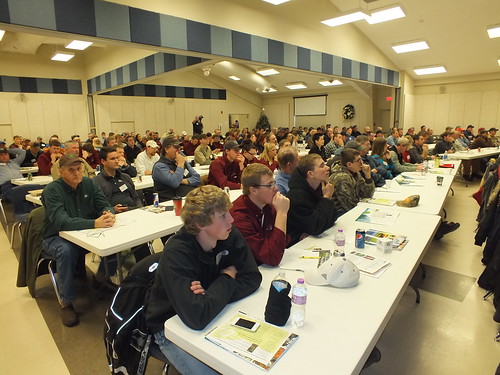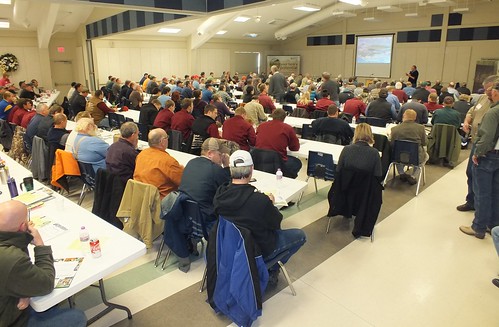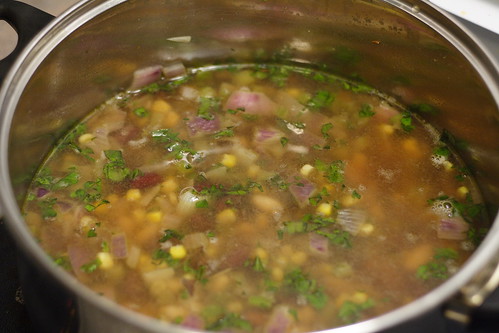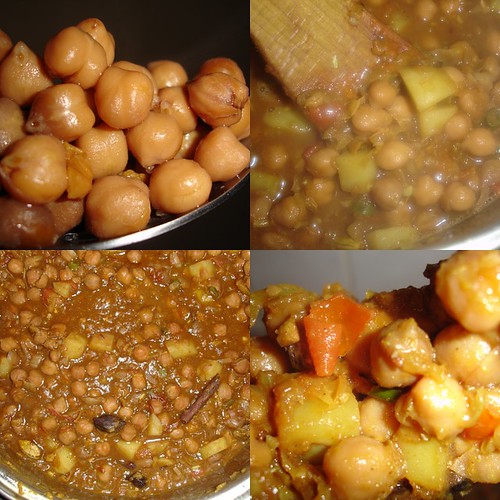2012 Soil Health Information Day, Mitchell, SD
Some cool healthy food choices images:
2012 Soil Health Information Day, Mitchell, SD

Image by NRCS SD
FOCUS FOR AG FUTURE: SOIL BIOLOGY AS “NEW FRONTIER”
NATURAL RESOURCES CONSERVATION SERVICE (NRCS), Pierre, SD, December 14, 2012—The inherent and dynamic qualities of soil were in the spotlight at the Soil Health Information Day held December 11, 2012 in Mitchell, SD. The event attracted over 230 people to hear regional and national agriculture and natural resources speakers.
Ruth Beck, SDSU Extension Agronomy Field Specialist, Pierre, says “One goal with the event was to help people learn ways to manage soil that improve the soil function. Although we can’t change the inherent qualities of the soil in our yards, fields and pastures, we can make management choices that affect the amount of organic matter, structure, depth, water and nutrient-holding capacity—the indicators of the health of a soil.”
“While the physical and chemical properties of soil have long been a main factor for land use planning, we are now getting an understanding of the biology happening beneath our feet,” says Colette Kessler, Public Affairs Specialist with the USDA Natural Resources Conservation Service (NRCS), Pierre. “Thanks to technology advances in microscopes and other equipment, our ‘understanding’ of the science of soil, biology in particular, has grown more in the last three years than the last 30,” she explains.
Two Alpena area farmers were enlisted to kick off the day demonstrating water infiltration with Ray Archuleta, Conservation Agronomist, from the NRCS East National Technical Center, Greensboro, NC. “Look at this…it isn’t a problem of run-off; we have an infiltration problem,” said Archuleta as the audience watched him work through the soil experiment. “Ray the Soil Guy” got to the ‘root’ of everyone’s questions with his presentation “Healthy Soils Make Healthy Profits.” Archuleta is passionate about soil health and his passion is infectious. He specializes in soil biology/ecology and diversity approaches for agro-ecosystem sustainability. “Understanding the biology—the microbes—in the soil is the ‘next step’ for farmers and ranchers,” says Archuleta. Every operation is unique. He outlined how to use above-ground management, such as crop rotations, cover crops, and reducing tillage as tools to manipulate the soil biology for a more sustainable system.
“A healthy soil is not compacted. It has structure with macro pores that allow water to infiltrate down into the profile,” Archuleta explained earlier. “When I pick up a shovelful of soil, it should look like cottage cheese.” Jim Hoorman, Ohio State University, via webinar, outlined their university research findings and the economics of using mixes of cover crops to improve the problem of compacted soils. Mixtures are better for addressing compaction than using a single cover crop species. Hoorman explained that disturbances, like tillage, can destroy pore structure in a soil. Good pore structure is very important, allowing the soil to breathe and move water.
“Healthy soil regulates water well,” explained Paul Jasa, Extension Engineer, University of Nebraska-Lincoln. Soil and residue management helps control where rain, snowmelt and irrigation water goes. “Field after field,” he says, “Residue drives the crop. Buffers are good, but a ‘band-aid;’ fix the soil in the field with residue and keep your water,” says Jasa. “Go out with a spade and see for yourself how your soil is handling water.”
Internationally known Dr. Dwayne Beck, Manager, SDSU Dakota Lakes Research Farm near Pierre, encourages producers to mimic nature, “I’ve learned more from observing nature than trying to change it.” Crop residue helps improve the soils balance of nutrients like nitrogen and phosphorus. Beck’s presentation outlined ‘Catch and Release Nutrients’ and working with natural cycles to maximize crop production. “Plant roots are ‘hot spots’ for biological activities like nutrient cycling and soil aggregate stability,” says Beck. Both living roots, and the dead or dying roots, improve water infiltration and break up compacted soils. An abundance of roots helps to stabilize biological activities below ground, making more nutrients and water available to plants.
A common theme recommended throughout the day was for people to get out in their yards, fields and pastures with a shovel. “If we dig a little, we can learn a lot,” says Kessler, “We can better understand how healthy soil should look and smell, and how healthy soil should feel in our hands.” By the year 2050, Earth’s population is expected to reach 9 billion. Keeping every inch of our soil healthy will be essential as farmers and ranchers work to produce as much food and fiber in the next 40 years as they have in the last 500.
Photos showing Soil health can also be found at: www.flickr.com/photos/87743206@N04/
2012 Soil Health Information Day, Mitchell, SD

Image by NRCS SD
FOCUS FOR AG FUTURE: SOIL BIOLOGY AS “NEW FRONTIER”
NATURAL RESOURCES CONSERVATION SERVICE (NRCS), Pierre, SD, December 14, 2012—The inherent and dynamic qualities of soil were in the spotlight at the Soil Health Information Day held December 11, 2012 in Mitchell, SD. The event attracted over 230 people to hear regional and national agriculture and natural resources speakers.
Ruth Beck, SDSU Extension Agronomy Field Specialist, Pierre, says “One goal with the event was to help people learn ways to manage soil that improve the soil function. Although we can’t change the inherent qualities of the soil in our yards, fields and pastures, we can make management choices that affect the amount of organic matter, structure, depth, water and nutrient-holding capacity—the indicators of the health of a soil.”
“While the physical and chemical properties of soil have long been a main factor for land use planning, we are now getting an understanding of the biology happening beneath our feet,” says Colette Kessler, Public Affairs Specialist with the USDA Natural Resources Conservation Service (NRCS), Pierre. “Thanks to technology advances in microscopes and other equipment, our ‘understanding’ of the science of soil, biology in particular, has grown more in the last three years than the last 30,” she explains.
Two Alpena area farmers were enlisted to kick off the day demonstrating water infiltration with Ray Archuleta, Conservation Agronomist, from the NRCS East National Technical Center, Greensboro, NC. “Look at this…it isn’t a problem of run-off; we have an infiltration problem,” said Archuleta as the audience watched him work through the soil experiment. “Ray the Soil Guy” got to the ‘root’ of everyone’s questions with his presentation “Healthy Soils Make Healthy Profits.” Archuleta is passionate about soil health and his passion is infectious. He specializes in soil biology/ecology and diversity approaches for agro-ecosystem sustainability. “Understanding the biology—the microbes—in the soil is the ‘next step’ for farmers and ranchers,” says Archuleta. Every operation is unique. He outlined how to use above-ground management, such as crop rotations, cover crops, and reducing tillage as tools to manipulate the soil biology for a more sustainable system.
“A healthy soil is not compacted. It has structure with macro pores that allow water to infiltrate down into the profile,” Archuleta explained earlier. “When I pick up a shovelful of soil, it should look like cottage cheese.” Jim Hoorman, Ohio State University, via webinar, outlined their university research findings and the economics of using mixes of cover crops to improve the problem of compacted soils. Mixtures are better for addressing compaction than using a single cover crop species. Hoorman explained that disturbances, like tillage, can destroy pore structure in a soil. Good pore structure is very important, allowing the soil to breathe and move water.
“Healthy soil regulates water well,” explained Paul Jasa, Extension Engineer, University of Nebraska-Lincoln. Soil and residue management helps control where rain, snowmelt and irrigation water goes. “Field after field,” he says, “Residue drives the crop. Buffers are good, but a ‘band-aid;’ fix the soil in the field with residue and keep your water,” says Jasa. “Go out with a spade and see for yourself how your soil is handling water.”
Internationally known Dr. Dwayne Beck, Manager, SDSU Dakota Lakes Research Farm near Pierre, encourages producers to mimic nature, “I’ve learned more from observing nature than trying to change it.” Crop residue helps improve the soils balance of nutrients like nitrogen and phosphorus. Beck’s presentation outlined ‘Catch and Release Nutrients’ and working with natural cycles to maximize crop production. “Plant roots are ‘hot spots’ for biological activities like nutrient cycling and soil aggregate stability,” says Beck. Both living roots, and the dead or dying roots, improve water infiltration and break up compacted soils. An abundance of roots helps to stabilize biological activities below ground, making more nutrients and water available to plants.
A common theme recommended throughout the day was for people to get out in their yards, fields and pastures with a shovel. “If we dig a little, we can learn a lot,” says Kessler, “We can better understand how healthy soil should look and smell, and how healthy soil should feel in our hands.” By the year 2050, Earth’s population is expected to reach 9 billion. Keeping every inch of our soil healthy will be essential as farmers and ranchers work to produce as much food and fiber in the next 40 years as they have in the last 500.
Photos showing Soil health can also be found at: www.flickr.com/photos/87743206@N04/
2012 Soil Health Information Day, Mitchell, SD

Image by NRCS SD
FOCUS FOR AG FUTURE: SOIL BIOLOGY AS “NEW FRONTIER”
NATURAL RESOURCES CONSERVATION SERVICE (NRCS), Pierre, SD, December 14, 2012—The inherent and dynamic qualities of soil were in the spotlight at the Soil Health Information Day held December 11, 2012 in Mitchell, SD. The event attracted over 230 people to hear regional and national agriculture and natural resources speakers.
Ruth Beck, SDSU Extension Agronomy Field Specialist, Pierre, says “One goal with the event was to help people learn ways to manage soil that improve the soil function. Although we can’t change the inherent qualities of the soil in our yards, fields and pastures, we can make management choices that affect the amount of organic matter, structure, depth, water and nutrient-holding capacity—the indicators of the health of a soil.”
“While the physical and chemical properties of soil have long been a main factor for land use planning, we are now getting an understanding of the biology happening beneath our feet,” says Colette Kessler, Public Affairs Specialist with the USDA Natural Resources Conservation Service (NRCS), Pierre. “Thanks to technology advances in microscopes and other equipment, our ‘understanding’ of the science of soil, biology in particular, has grown more in the last three years than the last 30,” she explains.
Two Alpena area farmers were enlisted to kick off the day demonstrating water infiltration with Ray Archuleta, Conservation Agronomist, from the NRCS East National Technical Center, Greensboro, NC. “Look at this…it isn’t a problem of run-off; we have an infiltration problem,” said Archuleta as the audience watched him work through the soil experiment. “Ray the Soil Guy” got to the ‘root’ of everyone’s questions with his presentation “Healthy Soils Make Healthy Profits.” Archuleta is passionate about soil health and his passion is infectious. He specializes in soil biology/ecology and diversity approaches for agro-ecosystem sustainability. “Understanding the biology—the microbes—in the soil is the ‘next step’ for farmers and ranchers,” says Archuleta. Every operation is unique. He outlined how to use above-ground management, such as crop rotations, cover crops, and reducing tillage as tools to manipulate the soil biology for a more sustainable system.
“A healthy soil is not compacted. It has structure with macro pores that allow water to infiltrate down into the profile,” Archuleta explained earlier. “When I pick up a shovelful of soil, it should look like cottage cheese.” Jim Hoorman, Ohio State University, via webinar, outlined their university research findings and the economics of using mixes of cover crops to improve the problem of compacted soils. Mixtures are better for addressing compaction than using a single cover crop species. Hoorman explained that disturbances, like tillage, can destroy pore structure in a soil. Good pore structure is very important, allowing the soil to breathe and move water.
“Healthy soil regulates water well,” explained Paul Jasa, Extension Engineer, University of Nebraska-Lincoln. Soil and residue management helps control where rain, snowmelt and irrigation water goes. “Field after field,” he says, “Residue drives the crop. Buffers are good, but a ‘band-aid;’ fix the soil in the field with residue and keep your water,” says Jasa. “Go out with a spade and see for yourself how your soil is handling water.”
Internationally known Dr. Dwayne Beck, Manager, SDSU Dakota Lakes Research Farm near Pierre, encourages producers to mimic nature, “I’ve learned more from observing nature than trying to change it.” Crop residue helps improve the soils balance of nutrients like nitrogen and phosphorus. Beck’s presentation outlined ‘Catch and Release Nutrients’ and working with natural cycles to maximize crop production. “Plant roots are ‘hot spots’ for biological activities like nutrient cycling and soil aggregate stability,” says Beck. Both living roots, and the dead or dying roots, improve water infiltration and break up compacted soils. An abundance of roots helps to stabilize biological activities below ground, making more nutrients and water available to plants.
A common theme recommended throughout the day was for people to get out in their yards, fields and pastures with a shovel. “If we dig a little, we can learn a lot,” says Kessler, “We can better understand how healthy soil should look and smell, and how healthy soil should feel in our hands.” By the year 2050, Earth’s population is expected to reach 9 billion. Keeping every inch of our soil healthy will be essential as farmers and ranchers work to produce as much food and fiber in the next 40 years as they have in the last 500.
Photos showing Soil health can also be found at: www.flickr.com/photos/87743206@N04/
Spicy Vegetarian Tortilla Soup Recipe
Check out these recipes images:
Spicy Vegetarian Tortilla Soup Recipe

Image by Greencolander
INGREDIENTS:
2 tbsp olive oil
1 large red onion, chopped
6 garlic cloves, minced
3 jalapeno peppers, seeded and chopped
1 tbsp cumin seed
1 cup frozen corn kernels
2 29 ounce cans vegetable broth
2 16 ounce cans kidney beans, rinsed and drained
1/3 cup chopped fresh cilantro, packed
1 cup shredded low-fat Monterey Jack cheese
6 corn tortillas
cooking spray
low-fat sour cream
lime wedges
PREPARATION:
Add olive oil, onion, garlic, jalapeno and cumin seed to a large pot over medium heat, stir constantly for 5 minutes. Add corn, vegetable broth, beans and cilantro.
Reduce heat, cover and simmer for 10 minutes.
Heat oven to 450 degrees. Coat cookie sheet with cooking spray, place tortillas on sheet and spray tortillas with cooking spray. Cook approximately 10 minutes. Cut tortillas into strips.
Top soup with cheese, tortilla strips and a dollop of sour cream. Garnish with lime.
chocolate chip cookie pie recipe nestle

Image by Christi @ Love From The Oven
Chocolate Chip Cookie Pie by Love From The Oven
www.lovefromtheoven.com/2011/03/14/chocolate-chip-cookie-…
Soft Buttered Pretzels
Check out these recipes images:
Soft Buttered Pretzels

Image by aida mollenkamp
Recipe for soft pretzels: bit.ly/r8VI7R
Beef Burgers

Image by Girl Interrupted Eating
with local beef , Lincolnshire Poacher Cheese, Chunky Ketchup
Longhorn Beef and Lincoln Red Beef Burgers this recipe and more on my blog Girl Interrupted Eating girlinterruptedeating.wordpress.com/2010/05/23/beef-burgers/
Chick pea curry

Image by rovingI
Recipe here
Cool Healthy Food Choices images
A few nice healthy food choices images I found:
20110407-OSEC-LSC-0136

Image by USDAgov
U.S. Department of Agriculture (USDA) Deputy Secretary Kathleen Merrigan looks up at the polled audience response being projected on a screen, during the presentation of the “Know your Farmer Know your Food” initiative to students and faculty at the Animal Sciences / Agricultural Engineering Building at the University of Maryland, in College Park, MD, on Thursday, April 7, 2011. Deputy Secretary Merrigan’s interactive presentation utilized wireless polling in the lecture room to present questions to the audience who used handheld devices to choose from a list of multiple answers. Their answers were instantly tabulated, then Merrigan revealed their top choice on the screen, followed by the correct answer, usually revealing an error and misconceptions. Her talk covered support of local farmers; strengthening rural communities, promoting healthy eating, protecting natural resources; grants, loans and other support USDA provides as well as stories of innovation; industry and government cooperation; and careers opportunities in agriculture, ranching and the USDA. USDA photo by Lance Cheung.
20110407-OSEC-LSC-0125

Image by USDAgov
University of Maryland students in the audience used wireless polling devices during U.S. Department of Agriculture (USDA) Deputy Secretary Kathleen Merrigan presentation of the “Know your Farmer Know your Food” initiative to students and faculty at the Animal Sciences / Agricultural Engineering Building at the University of Maryland, in College Park, MD, on Thursday, April 7, 2011. Deputy Secretary Merrigan’s interactive presentation utilized wireless polling in the lecture room to present questions to the audience who used handheld devices to choose from a list of multiple answers. Their answers were instantly tabulated, then Merrigan revealed their top choice on the screen, followed by the correct answer, usually revealing an error and misconceptions. Her talk covered support of local farmers; strengthening rural communities, promoting healthy eating, protecting natural resources; grants, loans and other support USDA provides as well as stories of innovation; industry and government cooperation; and careers opportunities in agriculture, ranching and the USDA. USDA photo by Lance Cheung.
20110407-OSEC-LSC-0099

Image by USDAgov
University of Maryland Senior Victoria Lake and others in the audience used wireless polling devices during U.S. Department of Agriculture’s (USDA) Deputy Secretary Kathleen Merrigan’s presentation of the “Know your Farmer Know your Food” initiative to students and faculty at the Animal Sciences / Agricultural Engineering Building at the University of Maryland, in College Park, MD, on Thursday, April 7, 2011. Deputy Secretary Merrigan’s interactive presentation utilized wireless polling in the lecture room to present questions to the audience who used handheld devices to choose from a list of multiple answers. Their answers were instantly tabulated, then Merrigan revealed their top choice on the screen, followed by the correct answer, usually revealing an error and misconceptions. Her talk covered support of local farmers; strengthening rural communities, promoting healthy eating, protecting natural resources; grants, loans and other support USDA provides as well as stories of innovation; industry and government cooperation; and careers opportunities in agriculture, ranching and the USDA. USDA photo by Lance Cheung.
Cool Healthy Food Choices images
Check out these healthy food choices images:
Camp FRESH 2010

Image by Christiana Care
Until this summer, Javiar Emory-Turner had never seen a tomato that wasn’t red.
At Camp FRESH, the 16-year-old Wilmington youth is not only tasting tomatoes that are yellow, green and orange, he is helping to grow and sell the produce.
Even more important, Javiar is taking the lessons he is learning about eating healthy home to his family and neighbors, encouraging them to eat five servings of fruits and vegetables each and every day.
"Before, I only ate fruits and vegetables about once a week," he said. "Now, I’m trying new foods that are healthy. I’m cutting back on sugar. I’m getting exercise."
Started by Christiana Care, Camp FRESH is a nine-week program for 48 young people ages 13-18 from Wilmington, New Castle and Newark, Del. The corner stores in their communities carry few fresh fruits and vegetables, and getting to larger markets with more food choices is sometimes difficult. These young gardeners from city neighborhoods till the soil at Wilmington Urban Farm, a verdant plot bursting with broccoli and bok choy, carrots and cabbage, zucchini and zinnias. By growing and eating healthy produce, the teens grow a healthy respect and appreciation for the value of nutrition, and they model their new respect for nutrition to others in the community, who also improve their diets-and, ultimately, their overall well being.
Christiana Care launched Camp FRESH in 2006 as part of the health system’s efforts to build an awareness of the value of nutrition, make a dent in obesity and improve the quality of life for these participants.
Two days a week, the teens sell produce at two stands in urban neighborhoods, one at the farm on East 12th Street and the other at Wilmington Hospital. On the other days, the youths gather at the Eugene du Pont Preventive Medicine and Rehabilitation Institute, where they make healthy dishes such as Asian coleslaw, made with Ramen noodles, cabbage and other accessible ingredients.
Campers were hesitant to taste when a bowl of edamame-baby soybeans popular in Japan-was passed around the room.
"Go ahead and try it," said Christopher Moore, Christiana Care healthy lifestyle coordinator. "Just squeeze the pod, and the beans pop right out."
About half the campers enjoyed the edamame. As for other healthy dishes, Hilda Hernandez, 16, feels good about trying hummus made from chick peas and red peppers.
"I thought it looked funny," she said. "But learning to eat things that are good for you is important if you want to stay healthy."
Already, Hilda has lost two pounds. She is walking more instead of taking the bus.
After lunch, she and the other campers got a rousing workout with Zumba, a Latin-inspired fitness regimen that harnesses the energy of music.
"Zumba is fun and makes me want to keep exercising," said Taylor Ferguson, 15, who has lost four pounds. "Now, I’m doing sit-ups and push-ups at home."
In addition to learning about nutrition and weight management, the teens talk about sex education, drug and alcohol abuse, strategies for being good ambassadors in the community and planning for the future.

